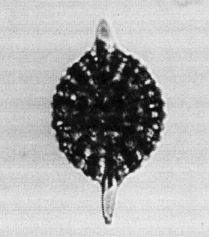 Stylacontarium
acquilonium (Hays)
Stylacontarium
acquilonium (Hays) Stylacontarium
acquilonium (Hays)
Stylacontarium
acquilonium (Hays)Druppatractus acquilonius Hays, 1970, p.214, pl.1, figs.4-5; Ling, 1975, p.717, pl.1, figs.17-18
Stylacontarium acquilonium (Hays) Kling, 1973, p.634, pl.1, figs.17-20, pl.14, figs.1-4; Ling, 1973, p.777, pl.1, figs.6-7
Cortical shell, ellipsoidal, usually thick-walled, but showing considerable variation in thickness, pores evenly spaced, circular to oval, with raised hexagonal borders, 6-7 across minor axis, short thorn-like projections arising from nodes. In some thick-walled individuals, the distal ends of these projections are connected. Shell bears two polar spines unequal in length, circular in cross section, distally sharpened, weakly three-bladed at base. Medullary shell single, ellipsoidal, composed of loose meshwork, pores large, irregular in shape, supported by 8-10 stout beams, 6-8 approximately in the equatorial plane, two along main axis being internal extensions of polar spines (Hays, 1970).
Based on 25 specimens. Length of major axis cortical shell 164-185 µm, width 132-162 µm, pore diameter 6-21 µm (usually about 17 µm), thickness 10-29 µm, median 21 µm, length of polar spines 35-79 µm. Length of medullary shell 47-57 µm, width 44-47 µm (Hays, 1970).
S. acquilonium is apparently restricted to the North Pacific. It is absent from the equatorial Pacific and from the Antarctic. Its morphotypic last appearance is just above the base of the Eucyrtidium matuyamai Zone in the North Pacific.
According to Reynolds (1980), this species evolved from S. sp. cf. S. acquilonium (= S. sp. aff. S. bispiculum of Kling, 1973, p.634) at or near the Miocene/Pliocene boundary.
According to Robertson (1975) heavy shelled specimens of Axoprunum stauraxonium (see Nigrini and Moore, 1979, p.S57) are similar to S. acquilonium, but A. stauraxonium is smaller in size (<165 µm, along the major axis).